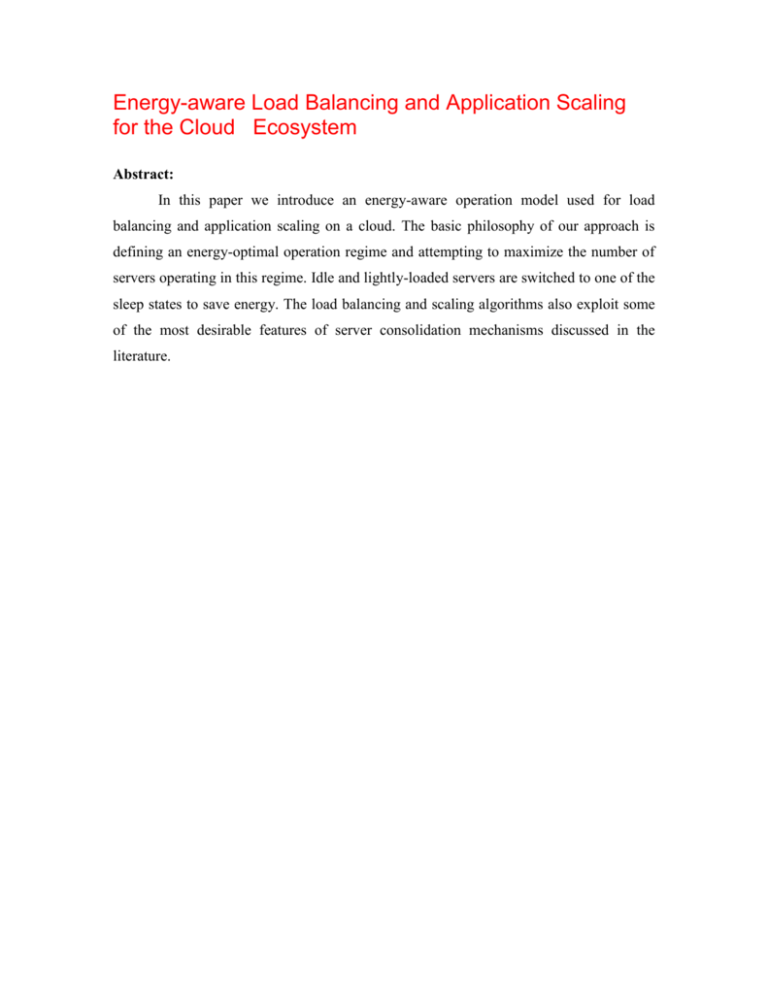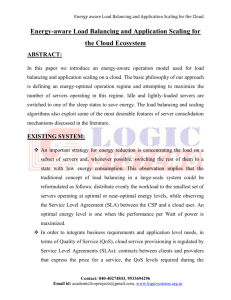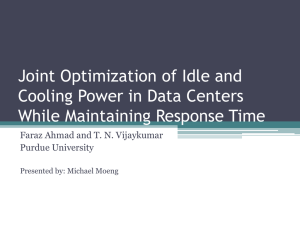Energy-aware Load Ba..
advertisement

Energy-aware Load Balancing and Application Scaling for the Cloud Ecosystem Abstract: In this paper we introduce an energy-aware operation model used for load balancing and application scaling on a cloud. The basic philosophy of our approach is defining an energy-optimal operation regime and attempting to maximize the number of servers operating in this regime. Idle and lightly-loaded servers are switched to one of the sleep states to save energy. The load balancing and scaling algorithms also exploit some of the most desirable features of server consolidation mechanisms discussed in the literature. Existing System We also assume a clustered organization, typical for existing cloud infrastructure When the existing applications scale up above of the capacity with all servers running then the cluster leader interacts with the leaders of other clusters to satisfy the requests. This case is not addressed in this paper. Proposed System we introduce an energy-aware operation model used for load balancing and application scaling on a cloud. The basic philosophy of our approach is defining an energy-optimal operation regime and attempting to maximize the number of servers operating in this regime. Idle and lightly-loaded servers are switched to one of the sleep states to save energy. The load balancing and scaling algorithms also exploit some of the most desirable features of server consolidation mechanisms discussed in the literature.. MODULES Load balancing, Application scaling Idle servers Server consolidation, Energy proportional systems. MODULES DESCRIPTION Load balancing The concept of load balancing" dates back to the time when the first distributed computing systems were implemented. It means exactly what the name implies, to evenly distribute the workload to a set of servers to maximize the throughput, minimize the response time, and increase the system resilience to faults by avoiding overloading the systems. Idle servers Idle and under-utilized servers contribute significantly to wasted energy, see Section survey reports that idle servers contribute 11 million tons of unnecessary CO2 emissions each year and that the total yearly costs for idle servers is billion. An energyproportional system consumes no energy when idle, very little energy under a light load, and gradually, more energy as the load increases. Server consolidation: The term server consolidation is used to describe: switching idle and lightly loaded systems to a sleep state; workload migration to prevent overloading of systems any optimization of cloud performance and energy efficiency by redistributing the workload discussed in Section For example, when deciding to migrate some of the VMs running on a server or to switch a server to a sleep state, we can adopt a conservative policy similar to the one advocated by autoscaling to save energy. Predictive policies, such as the ones discussed in will be used to allow a server to operate in a suboptimal regime when historical data regarding its workload indicates that it is likely to return to the optimal regime in the near future Energy proportional systems: The energy efficiency of a system is captured by the ratio performance per Watt of power." During the last two decades the performance of computing systems has increased much faster than their energy efficiency Energy proportional systems. In an ideal world, the energy consumed by an idle system should be near zero and grow linearly with the system load. In real life, even systems whose energy requirements scale linearly, when idle, use more than half the energy they use at full load. Data collected over a long period of time shows that the typical operating regime for data center servers is far from an optimal energy consumption regime. The dynamic range I s the dierence between the upper and the lower limits of the energy consumption of a system as a function of the load placed on the system. A large dynamic range means that a system is able to operate at a lower fraction of its peak energy when its load is low SYSTEM SPECIFICATION Hardware Requirements: System : Pentium IV 2.4 GHz. Hard Disk : 40 GB. Floppy Drive : 1.44 Mb. Monitor : 14’ Colour Monitor. Mouse : Optical Mouse. Ram : 512 Mb. Software Requirements: Operating system : Windows 7 Ultimate. Coding Language : ASP.Net with C# Front-End : Visual Studio 2010 Professional. Data Base : SQL Server 2008.




